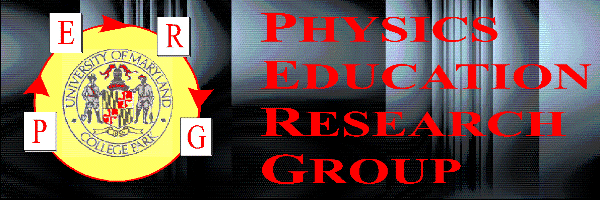
Measuring Student Expectations in University Physics:
The MPEX Survey
Edward F. Redish
Department of Physics, University of Maryland
College Park, MD 20742-4111
 Supported in part by NSF grant RED-9355849.
Supported in part by NSF grant RED-9355849.
Presented 7 January, 1997 at the Phoenix meeting of the AAPT. Posted
on the Web on 21 January, 1997.
Abstract
If we want to have a larger fraction of our students learn physics than is presently the case, we have to
understand what distinguishes successful from unsuccessful students. Students not only bring to class their
prior understanding of physics concepts, they bring assumptions about the nature of physics knowledge, what
they are to learn, what skills will be required, and what they need to do to succeed. These "expectations"
affect not only how students interpret class activities, but the type of understanding they build. To probe the
distribution and impact of these expectations, we have created the Maryland Physics Expectations (MPEX)
Survey, a set of statements with which students are asked to agree or disagree. Observations of more than
2000 students at a dozen institutions in first semester physics classes show that many students have
expectation misconceptions. Furthermore, the first semester class tends to deteriorate rather than improve
these expectations.
The talk was originally designed to be presented using a browser (Netscape).
Though it is all one document, the buttons can be used to present the talk
in slide format. To get the proper size for a slide show, place the horizontal bar below at
the top of your screen and adjust your window size so that this bar goes all the way across,
and the height so that the next horizontal bar is at the bottom. If you are using a 640x480 screen,
there should be no need to resize.
Proceed to talk.
Measuring Student Expectations in University Physics:
The MPEX Survey
Supported in part by NSF grant RED-9355849
 1
1

 2
2
Many members of the University of Maryland Physics Education Research Group have contributed to this research.
| Faculty | Postdoc |
|---|
| E. F. Redish | Richard Steinberg |
| John Layman | Grad Students |
|---|
| Angelo Bardasis (dec.) | Lei Bao |
| Visitors | John Lello |
|---|
| Al Sapirstein | Mel Sabella |
| John Christopher | Jeff Saul |
| Pratibha Jolly | Michael Wittmann |

 3
3
Outline

 3
3
I. Motivation:�Why study expectations?
- Our changing audience�
- What can we offer?
- What are the barriers?

 5
5
Our changing audience
Physics majors are special
- They will see the material again.
- Most will eventually have a chance to teach it (as TAís) or do research using it.
- They donít have to get it the first time through.
However, less than 1% of students in introductory physics will go on to graduate school in physics. Less than 3% will ever take another physics course.

 6
6
What can we offer?
Although physics is and will continue to be needed by all scientists and engineers, it does not need to be taught by physicists in a separate course.
If we want to keep our students, we need to offer them help in developing those skills we can do best.
- understanding concepts
- effective problem-solving skills (not plug-and-chug)
- back-of-the-envelope calculations
- a sense of understanding how the world works.

 7
7
What are the barriers?
- Some students believe that physics consists of unrelated "facts".
- Some students believe that they donít need to understand why we believe something in physics is true -- just that it is.
- Some students believe that they donít need to understand the meaning behind an equation -- just to use it to calculate the "right" number.
- Some students believe their real-world experience is irrelevant to their physics class -- and vice versa.

 8
8
These barriers cause problems
- Students select only a small part of what is offered in a typical firehose physics course.
- Their "filters" depend on their ideas about the nature of physics and the course.
- If we want to improve their attitudes and understanding as well as their content knowledge, we have to understand where they are starting from and what causes change.

 9
9
II. Learning in adults: What is known?
Two important studies of the development of student attitudes, expectations, and epistemologies -- outside of science -- are:
- Forms of Intellectual and Ethical Development by William Perry�
- Women's Ways of Knowing by Belenky, Clinchy, Goldberger, and Tarule (BCGT)

 10
10
Stages of adult expectations
According to Perry and BCGT, adult learners go through stages in their understanding the nature of knowledge:
- Binary: reliance on authority and transmitted information -- transmissionism
- Relativist: understanding otherís views ó relativism / empathic knowledge
- Constructivist: making a commitment and building oneís own view

 11Characteristics of Student Expectations
11Characteristics of Student Expectations
| Favorable | Unfavorable |
|---|
| independence | learns independently, believes in their own need to evaluate and under-stand | takes what is given by authorities (teacher, text) without evaluation |
|---|
| coherence | believes physics needs to be considered as a connected, consistent framework | believes physics can be treated as separated facts or "pieces" |
|---|
| concepts | stresses understanding of the underlying ideas and concepts | focuses on memorizing and using formulas |
|---|
| reality link | believes ideas learned in physics are useful in a wide variety of real contexts | believes ideas learned in physics are unrelated to experiences outside the classroom |
|---|
| math link | considers mathematics as a convenient way of representing physical phenomena | views the physics and the math as independent with no strong relationship between them |
|---|
| effort | makes the effort to use the information available and tries to make sense of it | does not attempt to use available information effectively |
|---|

 12
12
Two things seem clear:
- Students who are to become effective scientists or engineers must make the transition to favorable attitudes.
- Students in the authority / received knowledge stages in their scientific work may be confirmed in their views by the traditional introductory approach.
Further study of the building of appropriate scientific attitudes is needed.

 13
13
III. The MPEX Survey: Measuring attitudes
Goals of the study:
- to determine the distribution of student attitudes, beliefs, and epistemologies that have an effect on what they take away from a physics class;
- to better explicate the "hidden" curriculum;
- to better understand the implications of traditional and innovative instruction for student learning,

 14
14
Why a Survey?
Some positives
- May be delivered quickly and easily to large numbers of students
- May be analyzed quantitatively
Some negatives
- May be misread by some students
- Only shows what students think they think -- not what they actually think

 15
15
The MPEX Survey
- Contains 34 statements with which students are asked to agree or disagree on a 5 point scale
- Delivered at more than 17 colleges and universities to more than 3000 students.

 16
16
Institutions Tested
| Institution | Instructional Characteristics | N |
|---|
| University of Maryland, College Park (UMCP) | traditional, some classes with group-learning tutorial instead of recitation | 445 |
|---|
| University of Minnesota, Minneapolis (UMN) | traditional, group-learning research designed problem-solving and labs | 467 |
|---|
| Ohio State University, Columbus (OSU) | traditional, some group learning problem solving sections, some interactive lectures | 445 |
|---|
| Dickinson College | Workshop Physics | 115 |
|---|
| a small public liberal arts university (LA) | Workshop Physics | 12 |
|---|
| a medium sized public two-year college (TYC) | traditional | 44 |
|---|

 17
17
Calibrating the Survey
- Student readings and interpretations were clarified by detailed interviews.
- We conjectured that responses of increasingly sophisticated groups would agree with our predicted "favorable" responses. ("Face validity")

 18
18
Calibration Groups
- Beginning physics students in the UMd engineering physics class (UMd pre)
- Top high school students (Physics Olympics team)
- Experienced high school teachers interested in exploring interactive educational methods -- attendees at Dickinson College Summer Seminar (HS teachers)
- Experienced college teachers interested in exploring interactive educational methods methods -- attendees at Dickinson College Summer Seminar (College Teachers)
- Experienced college teachers committed to introducing interactive educational methods (Expert group)

 19
19
The A-D Plot
- Displays % of responses that agree with our predicted "favorable" response.
- Plot % unfavorable vs. % favorable on an x-y plot�
- Responses must lie below descending diagonal.
|  |

 20
20
Calibration Results: Overall
- The responses of the validation groups for each item are averaged.
- Average results agree well with prediction.
|
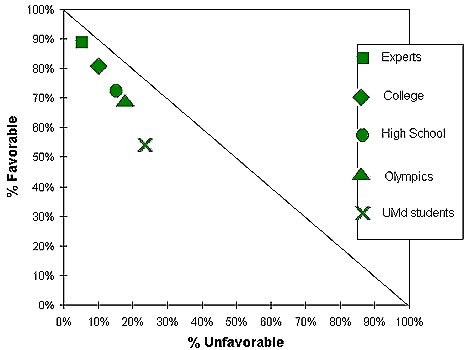 |

 20a
20a
Data collection procedure
- Surveys were given both at the beginning of the mechanics semester or quarter (pre) and at the end (post).
- Surveys are only included in the sample if the student completed both pre and post surveys. ("matched")

 21
21
Overall Results: Large Universities (M)
- Introductory mechanics (calculus based) at 3 large research universities: about 500 students each
- Initial distribution far from ideal.
- Result of instruction is a loss, not a gain.
|
 |

 22
22
Overall Results: Small Colleges (M)
- Introductory mechanics (calculus based) at 3 small colleges: about 20-100 students each
- Initial distribution far from ideal.
- Result of instruction is a loss, not a gain.
|
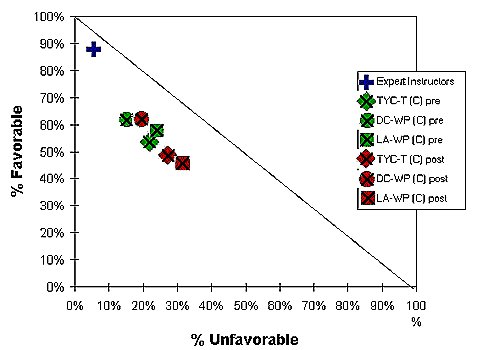 |

 23
23
Items of the Math Cluster
- All I learn from a derivation or proof of a formula is that the formula obtained is valid and that it is OK to use it in problems.
- I spend a lot of time figuring out and understanding at least some of the derivations or proofs given either in class or in the text.
- In this course, I do not expect to understand equations in an intuitive sense; they just have to be taken as givens.
- The derivations and proofs of equations in class or in the text has little to do with solving problems or with the skills I will need to succeed in this course.
- If I don't remember a particular equation needed for a problem in an exam there is nothing much I could do (legally!) to come up with it.

 24
24
Math Cluster: Calibration Group
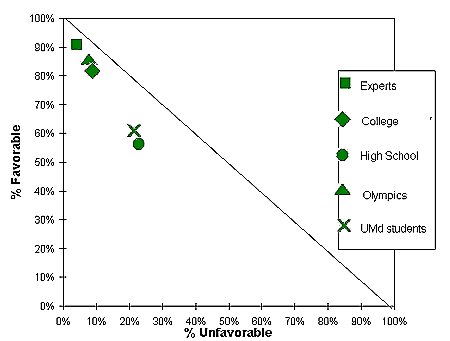

 25
25
Math Cluster: Large Universities
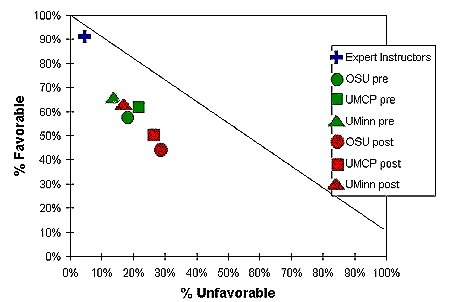

 26
26
Math Cluster: Small Colleges
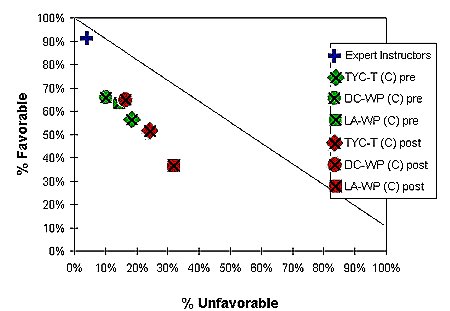

 27
27
Items of the Effort Cluster
- I go over my class notes carefully in preparation for exams in this course.
- I spend a lot of time figuring out and understanding at least some of the derivations or proofs given either in class or in the text.
- I read the text in detail and worked through many of the examples given there.
- The results of an exam don't give me any useful guidance to improve my understanding of the course material. All the learning associated with an exam is in the studying I do before it takes place.
- I use the mistakes I make on homework and on exam problems as clues to what I need to do to understand the material better.

 28
28
Effort Cluster: Calibration Group
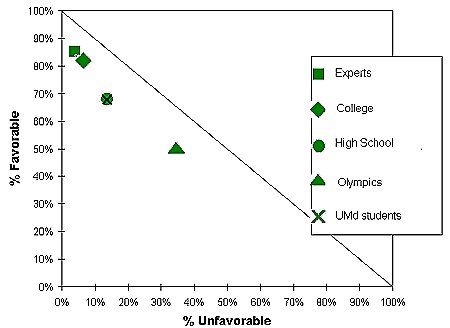

 29
29
Effort Cluster: All Schools
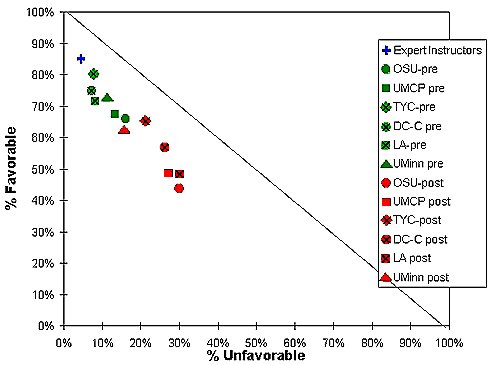

 30
30
IV. Implications and Conclusions: �Now What?
- Having these items explicated, and having a way to look at them allows us to discuss what are real goals are for a course.
- Note that the two institutions with coherent, research designed programs (UMn and DC) showed significantly smaller losses than the other schools.
- Some schools showed substantial deterioration of attitudes after instruction.
 31
31
Many Questions Remain
- Long term longitudinal studies are needed.
- We need to determine which students are losing ground and which ones are gaining.
- We need to determine the extent to which our evaluations (exams) encourage or discourage attitudinal change.
- We need to discover instructional strategies that affect student attitudes positively.
This page prepared by
Edward F. Redish
redish@quark.umd.edu
University of Maryland
Physics Department
College Park, MD 20742-4111
(301) 405-6120
For more information on the MPEX Survey and the University of Maryland Expectations
project, click here.
 Supported in part by NSF grant RED-9355849.
Supported in part by NSF grant RED-9355849.

 Supported in part by NSF grant RED-9355849.
Supported in part by NSF grant RED-9355849.








